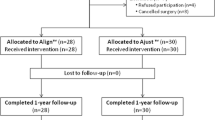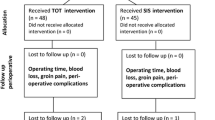Abstract
Introduction and hypothesis
Midurethral sling procedures are the first surgical option in women undergoing surgery for stress urinary incontinence (SUI). Single-incision midurethral-slings (SIMS) were designed to provide similar efficacy to traditional midurethral slings but with reduced morbidity. In this international trial we compared the efficacy of a SIMS (MiniArc) and a transobturator standard midurethral sling (SMUS; Monarc) in the treatment of SUI in terms of subjective and objective cure rates and morbidity over a long-term follow-up.
Methods
This was a randomized controlled nonblinded extended trial with a follow-up period of 36 months. Women with symptomatic SUI were eligible. The primary outcome was subjective cure, defined as an improvement in the Patient Global Impression of Improvement (PGI-I) score. Secondary outcomes were objective cure (negative cough stress test), disease-specific quality of life, surgical parameters and morbidity. An intention to treat analysis was performed. Differences in dichotomous variables were tested using the chi-squared test. Differences in continuous variables were tested using Student’s t test or the Mann-Whitney U test. We hypothesized that MiniArc would be noninferior to Monarc concerning subjective cure.
Results
We randomized 97 women to the MiniArc group and 96 to the Monarc group. The attrition rate was 23% in the MiniArc group and 22% in the Monarc group after 3 years. At 36 months, the subjective cure rates were 86% in the MiniArc group and 87% in the Monarc group (risk difference −0.6%, 95% CI −12 to 11%). The objective cure rates were 89% and 88%, respectively (risk difference 1.3%, 95% CI −9 to 11%). Both procedures were associated with low complication rates.
Conclusions
After a follow-up of 36 months, MiniArc (SIMS) is non-inferior to Monarc (SMUS) with respect to subjective and objective cure.

Similar content being viewed by others
References
Garely AD, Noor N. Diagnosis and surgical treatment of stress urinary incontinence. Obstet Gynecol. 2014;124:1011–27.
Liu B, Wang L, Huang SS, Wu Q, Wu DL. Prevalence and risk factors of urinary incontinence among Chinese women in Shanghai. Int J Clin Exp Med. 2014;7:686–96.
Richardson ML, Sokol ER. A cost-effectiveness analysis of conservative versus surgical management for the initial treatment of stress urinary incontinence. Am J Obstet Gynecol. 2014;211:565.e1–e6.
Hinoul P, Vervest HA, Den Boon J, et al. A randomized, controlled trial comparing an innovative single incision sling with an established transobturator sling to treat female stress urinary incontinence. J Urol. 2011;185:1356–62.
Abdel-Fattah M, Ford JA, Lim CP, Madhuvrata P. Single-incision mini-slings versus standard midurethral slings in surgical management of female stress urinary incontinence: a meta-analysis of effectiveness and complications. Eur Urol. 2011;60:468–80.
Kennelly MJ, Moore R, Nguyen JN, Lukban JC, Siegel S. Prospective evaluation of a single incision sling for stress urinary incontinence. J Urol. 2010;184:604–9.
Kennelly MJ, Moore R, Nguyen JN, Lukban J, Siegel S. MiniArc single-incision sling for treatment of stress urinary incontinence: 2-year clinical outcomes. Int Urogynecol J. 2012;23:1285–91.
Lee JK, Rosamilia A, Dwyer PL, Lim YN, Muller R. Randomized trial of a single incision versus an outside-in transobturator midurethral sling in women with stress urinary incontinence: 12 month results. Am J Obstet Gynecol. 2015;213:35.e1–e9
Schellart RP, Oude Rengerink K, Van der Aa F, et al. A randomized comparison of a single-incision midurethral sling and a transobturator midurethral sling in women with stress urinary incontinence: results of 12-mo follow-up. Eur Urol. 2014;66:1179–85.
Schellart RP, Oude Rengerink K, Van der Aa F, et al. A randomised comparison of single-incision versus traditional transobturator midurethral sling in women with stress urinary incontinence: results of a 24-month follow-up. Int Urogynecol J. 2016;27:871–7.
Lucas MG, Bedretdinova D, Bosch JLHR, et al. Guidelines on urinary incontinence. European Association of Urology; 2014. http://uroweb.org/wp-content/uploads/20-Urinary-Incontinence_LR.pdf. Accessed: 13 Oct 2014.
Bump RC, Mattiasson A, Bø K, et al. The standardization of terminology of female pelvic organ prolapse and pelvic floor dysfunction. Am J Obstet Gynecol. 1996;175:10–7.
Nager CW, Brubaker L, Litman HJ, et al. A randomized trial of urodynamic testing before stress-incontinence surgery. N Engl J Med. 2012;366:1987–97.
Yalcin I, Bump RC. Validation of two global impression questionnaires for incontinence. Am J Obstet Gynecol. 2003;189:98–101.
Van der Vaart CH, de Leeuw JR, Roovers JP, Heintz AP. Measuring health-related quality of life in women with urogenital dysfunction: the Urogenital Distress Inventory and Incontinence Impact Questionnaire revisited. Neurourol Urodyn. 2003;22:97–104.
Laurikainen E, Valpas A, Kivelä A, et al. Retropubic compared with transobturator tape placement in treatment of urinary incontinence: a randomized controlled trial. Obstet Gynecol. 2007;109:4–11.
Deffieux X, Daher N, Mansoor A, Debodinance P, Muhlstein J, Fernandez H. Transobturator TVT-O versus retropubic TVT: results of a multicenter randomized controlled trial at 24 months follow-up. Int Urogynecol J. 2010;21:1337–45.
Laurikainen E, Valpas A, Aukee P, et al. Five-year results of a randomized trial comparing retropubic and transobturator midurethral slings for stress incontinence. Eur Urol. 2014;65:1109–14.
Natale F, Dati S, La Penna C, Rombolà P, Cappello S, Piccione E. Single incision sling (Ajust™) for the treatment of female stress urinary incontinence: 2-year follow-up. Eur J Obstet Gynecol Reprod Biol. 2014;182C:48–52.
Amat I, Tardiu L, Martínez Franco E, Laïlla Vicens JM. Contasure-Needleless compared with transobturator-TVT for the treatment of stress urinary incontinence. Int Urogynecol J. 2011;22:827–33.
Martinez Franco E, Amat Tardiu L. Contasure-Needleless® single incision sling compared with transobturator TVT-O® for the treatment of stress urinary incontinence: long-term results. Int Urogynecol J. 2015;26:213–8.
Presthus JB, Van Drie D, Graham C. MiniArc single-incision sling in the office setting. Minim Invasive Gynecol. 2012;19:331–8.
Yildiz G, Ceylan Y, Ucer O, Arslan D, Celik O, Gunlusov B. Safety and efficacy of single-incision sling for female stress urinary incontinence: 3 years’ results. Int Urogynecol J. 2016;27:1667–71.
Hinoul P, Vanormelingen L, Roovers JP, de Jonge E, Smajda S. Anatomical variability in the trajectory of the inside-out transobturator vaginal tape technique (TVT-O). Int Urogynecol J Pelvic Floor Dysfunct. 2007;18:1201–6.
Burkhard C, Lucas MG, Berghmans LC, et al. EAU Guidelines on Urinary Incontinence in Adults. European Association of Urology; 2016. http://www.uroweb.org/guidelines/online-guidelines/. Accessed: 2016.
Mostafa A, Lim CP, Hopper L, Madhuvrata P, Abdel-Fattah M. Single-incision mini-slings versus standard midurethral slings in surgical management of female stress urinary incontinence: an updated systematic review and meta-analysis of effectiveness and complications. Eur Urol. 2014;65:402–27.
Acknowledgements
Valuable help in the collection of data was given by Leon Bos, medical student.
Author information
Authors and Affiliations
Corresponding author
Ethics declarations
Funding
The trial was supported by an unrestricted research grant from ASTORA™ Women’s Health.
Disclosure statement
R.P. Schellart: ASTORA™ Women’s Health: grant/research support.
S.E. Zwolsman: Reports no conflicts of interest.
J.P. Lucot: Boston Scientific: surgical teaching sessions.
D.J.M.K. de Ridder: ASTORA™ Women’s Health: surgical teaching sessions, speaker.
M.G.W. Dijkgraaf: Reports no conflicts of interest.
J.P.W.R. Roovers: ASTORA™ Women’s Health: scientific medical advisor, grant/research support. Bard Medical: independent research grant. Coloplast: independent research grant.
Additional information
Ethical considerations and registration of clinical trial
The trial was registered with the Netherlands Trial Register (NTR3783; http://www.trialregister.nl/trialreg/index.asp) and was approved by the medical ethics committees of all participating centers (MEC numbers B32220107859; F 201-A00147-32; NL28973.018.09).
Rights and permissions
About this article
Cite this article
Schellart, R.P., Zwolsman, S.E., Lucot, JP. et al. A randomized, nonblinded extension study of single-incision versus transobturator midurethral sling in women with stress urinary incontinence. Int Urogynecol J 29, 37–44 (2018). https://doi.org/10.1007/s00192-017-3362-z
Received:
Accepted:
Published:
Issue Date:
DOI: https://doi.org/10.1007/s00192-017-3362-z




